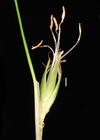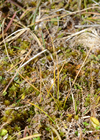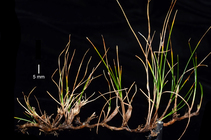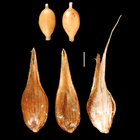Cyperaceae taxon details
Carex pilifolia K.A.Ford
1799268 (urn:lsid:marinespecies.org:taxname:1799268)
accepted
Species
recent only
Ford, K. A. (2025). A taxonomic revision of New Zealand species of <i>Carex</i> section <i>Inversae</i> Kük. (<i>Carex</i> subgenus <i>Vignea</i>, Cyperaceae). <em>New Zealand Journal of Botany.</em> 1-73., available online at https://doi.org/10.1080/0028825x.2025.2458506
page(s): 51 [details] Available for editors [request]
[request]
page(s): 51 [details] Available for editors
Holotype CHR 666747, geounit New Zealand South
Holotype CHR 666747, geounit New Zealand South [details]
Description Small, lax, filiform-leaved tufts; rhizomes fine, wiry, long-creeping, branching, and internodes short. Culms 10–46 mm...
Etymology From Latin pilus, a hair, and folium, a leaf.
Description Small, lax, filiform-leaved tufts; rhizomes fine, wiry, long-creeping, branching, and internodes short. Culms 10–46 mm long × 0.3–0.4 mm diam., erect, trigonous, glabrous, smooth, enclosed by leaf-sheaths; produced in clusters along the rhizome. Leaves >> culms; leaf-sheaths enclosing culm, brown; ligule apex obtuse; leaf-blades 25–85 long × 0.3–0.4 mm wide, lax, involute to subterete above, margins minutely scabrid above, sometimes only at apex, green or green-yellow, leaf apex sub-acute or obtuse, obscurely trigonous to flat. Inflorescence 6–10 × 4–5 mm, spicate, with 1 spike at the top of the culm; lowest spike bract 7–20 mm long, filiform, > inflorescence; spikes ovoid, green maturing to brown, male flowers above female, densely flowered. Male flowers 1–3 per spike, stamens 2, anthers 1.3–2.0 mm long. Female glumes 5.5–8.0 mm long, >> utricles, narrow ovate, brown to pale straw with a straw-coloured mid-vein, margins entire and membranous, apex long acuminate, awn-like. Utricles 4.6–6.0 mm long × 1.2–1.6 mm wide, ovate, plano-convex, coriaceous, smooth, pithy at base, both surfaces distinctly nerved, narrowly winged, margins scabrid above, green, brown to red-brown; beak 2.0–3.0 mm long, tapering, split, pale to light brown; orifice bifid, glabrous; stipe tapered. Stigmas 2. Achenes 1.4–2.0 mm long × 0.9–1.2 mm wide, unequally biconvex, plano-convex, broadly ovate, faintly papillose, light brown, cream-brown. [details]
Etymology From Latin pilus, a hair, and folium, a leaf.
Etymology From Latin pilus, a hair, and folium, a leaf. [details]
Cyperaceae Working Group. (2025). [see How to cite]. Global Cyperaceae Database. Carex pilifolia K.A.Ford. Accessed at: https://cyperaceae.org/aphia.php?p=taxdetails&id=1799268 on 2025-09-12
Date
action
by
![]() The webpage text is licensed under a Creative Commons
Attribution 4.0 License
The webpage text is licensed under a Creative Commons
Attribution 4.0 License
Nomenclature
original description
Ford, K. A. (2025). A taxonomic revision of New Zealand species of <i>Carex</i> section <i>Inversae</i> Kük. (<i>Carex</i> subgenus <i>Vignea</i>, Cyperaceae). <em>New Zealand Journal of Botany.</em> 1-73., available online at https://doi.org/10.1080/0028825x.2025.2458506
page(s): 51 [details] Available for editors [request]
[request]
page(s): 51 [details] Available for editors
 Present
Present  Inaccurate
Inaccurate  Introduced: alien
Introduced: alien  Containing type locality
Containing type locality
Holotype CHR 666747, geounit New Zealand South [details]
From editor or global species database
Description Small, lax, filiform-leaved tufts; rhizomes fine, wiry, long-creeping, branching, and internodes short. Culms 10–46 mm long × 0.3–0.4 mm diam., erect, trigonous, glabrous, smooth, enclosed by leaf-sheaths; produced in clusters along the rhizome. Leaves >> culms; leaf-sheaths enclosing culm, brown; ligule apex obtuse; leaf-blades 25–85 long × 0.3–0.4 mm wide, lax, involute to subterete above, margins minutely scabrid above, sometimes only at apex, green or green-yellow, leaf apex sub-acute or obtuse, obscurely trigonous to flat. Inflorescence 6–10 × 4–5 mm, spicate, with 1 spike at the top of the culm; lowest spike bract 7–20 mm long, filiform, > inflorescence; spikes ovoid, green maturing to brown, male flowers above female, densely flowered. Male flowers 1–3 per spike, stamens 2, anthers 1.3–2.0 mm long. Female glumes 5.5–8.0 mm long, >> utricles, narrow ovate, brown to pale straw with a straw-coloured mid-vein, margins entire and membranous, apex long acuminate, awn-like. Utricles 4.6–6.0 mm long × 1.2–1.6 mm wide, ovate, plano-convex, coriaceous, smooth, pithy at base, both surfaces distinctly nerved, narrowly winged, margins scabrid above, green, brown to red-brown; beak 2.0–3.0 mm long, tapering, split, pale to light brown; orifice bifid, glabrous; stipe tapered. Stigmas 2. Achenes 1.4–2.0 mm long × 0.9–1.2 mm wide, unequally biconvex, plano-convex, broadly ovate, faintly papillose, light brown, cream-brown. [details]Diagnosis Differs from Carex ambita by its small size, sparse-leaved, tufted habit; inflorescence reduced to a single spike; female glume >> utricle, with an elongated acuminate apice; and utricles that are larger and coriaceous in texture. [details]
Etymology From Latin pilus, a hair, and folium, a leaf. [details]
Habitat Montane, 760–920 m; inter-montane basins and glacial valleys; moraine, upper turf zone of kettleholes and associated shallow fluvial channels; buried within turf vegetation; with Agrostis capillaris, Anthoxanthum odoratum, Carex gaudichaudiana, C. resectans, Coprosma atropurpurea, C. petriei, Crassula sinclairii, Deschampsia chapmanii, Epilobium angustum, Festuca rubra, Galium perpusillum, Hypericum rubicundulum, Isolepis basilaris, Leptinella dioica, Lobelia ionantha, L. perpusilla, Philonotis tenuis, Plantago triandra, Polytrichum commune, Polytrichastrum longisetum, Prunella vulgaris, Trifolium repens, Viola cunninghamii. [details]










